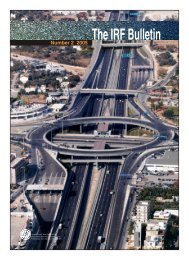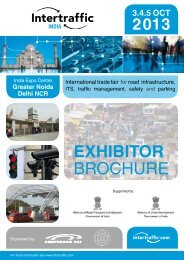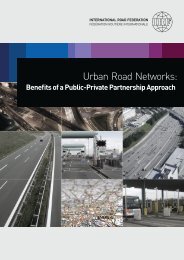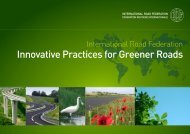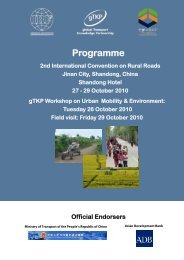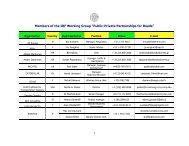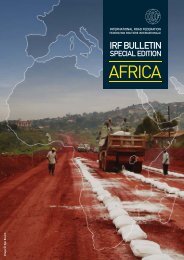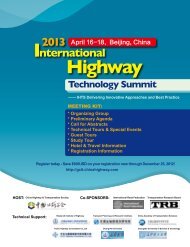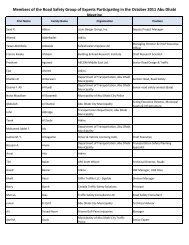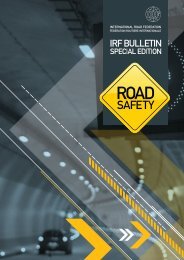TRANSPORT
TRANSPORT
TRANSPORT
- No tags were found...
Create successful ePaper yourself
Turn your PDF publications into a flip-book with our unique Google optimized e-Paper software.
MANAGEMENT<br />
programmes that directly benefit the poor. The types of<br />
activities covered typically include: group mobilisation;<br />
life skills education (group savings, planting and caring<br />
for trees etc.); credit/income generation; and beneficiary<br />
training/capacity building (group accounts management;<br />
participatory leadership development; awareness and<br />
ownership building; gender awareness).<br />
A dynamic gender equity strategy provides guidance aimed<br />
at ensuring that men and women have equitable input in<br />
the planning and management of LGED projects – and that<br />
both sexes benefit equally from the overall programme.<br />
Environmental and climate change issues are, today,<br />
being increasingly talked about throughout the world.<br />
For its part, LGED had already begun mainstreaming<br />
these concerns from as early as 1994 in its rural roads<br />
development activities. With respect to each sub-project,<br />
environmental considerations are taken into account in<br />
the relevant bill of quantities, and duly reflected in the<br />
work executed by the contractor. LGED has developed an<br />
Environment Framework as well as an Environment Code<br />
of Practice Manual to guide environmental supervision and<br />
monitoring.<br />
Furthermore, numerous studies have been conducted<br />
on the development impacts of improved transport and<br />
trading infrastructures. The results of these studies are<br />
summarised in the table below:<br />
Development Impacts<br />
Cost Savings<br />
• Motorised Transport (MT) increased by 360%, while<br />
Non-Motorised Transport rose by 242%.<br />
• Freight carried by MT went up 98% on average.<br />
• Transport costs were reduced by one third for both MT<br />
and NMT.<br />
• Travel time declined by about 30%.<br />
• Vehicle Operating Costs went down by 7% for MT<br />
and 10% for NMT.<br />
Education<br />
• Faster rate of increase in the numbers of teachers in<br />
educational institutions.<br />
• A similarly significant rise in the number of female<br />
teachers were observed.<br />
• Notable improvement in the rate of female student<br />
enrolment.<br />
• Total enrolment went up from 19.4% to 29.4%,<br />
while female enrolment increased from 12.9% to<br />
31.7%.<br />
• The numbers of students dropping out went down<br />
by 14%.<br />
Health<br />
• Increases in the numbers of visits by patients to<br />
healthcare centres in project areas; with female patient<br />
visits growing at a faster rate. This demonstrates the<br />
positive impact better developed roads can have on<br />
access to essential health services by female patients.<br />
• Significant growth in doctors’ attendance at rural<br />
hospitals.<br />
Agriculture<br />
• Average yields per hectare of various food and cash<br />
crops increased by 6%.<br />
• Farm-gate and home-based sales both increased, by<br />
50% and 65% respectively.<br />
• Average roadside land prices have risen by 278%.<br />
These findings may be further viewed in the context<br />
of encouraging overall economic development and<br />
achievement in Bangladesh. The Economic Survey-2007<br />
& Study reveals that, since independence, GDP has<br />
tripled (from US$ 224 in 1971 to US$ 599 in 2008); food<br />
production has similarly tripled; the rate of population<br />
growth has declined (from 2.9% in 1974 to 1.4% in 2006);<br />
the literacy rate has increased from 23% to 67%; child<br />
mortality has fallen substantially; the incidence of poverty<br />
has been reduced, from 51% in 1995-96 to 40% in 2005;<br />
and gender parity has been achieved. In short, Bangladesh<br />
is currently well on track to becoming a Middle-Income<br />
Country by 2020.<br />
This steady progress is symbolised by the country’s<br />
commendable efforts to promote the socio-economic<br />
development of its rural areas through the provision of<br />
appropriate transport infrastructure.<br />
1. A Thana is a former administrative division of Bangladesh,<br />
corresponding to a sub-District. It has subsequently been superseded<br />
by Upazila Parishads (see note 2).<br />
2. Rural local government in Bangladesh is currently divided into four<br />
tiers: Zila (District) Parishads; Upazila Parishads; Union Parishads, and<br />
Gram (Village) Parishads.<br />
IRF BULLETIN SPECIAL EDITION: RURAL <strong>TRANSPORT</strong>, VOLUME-2 |<br />
25



